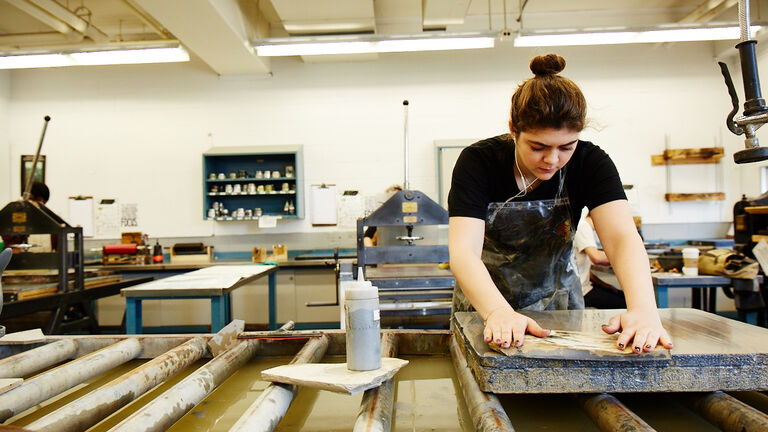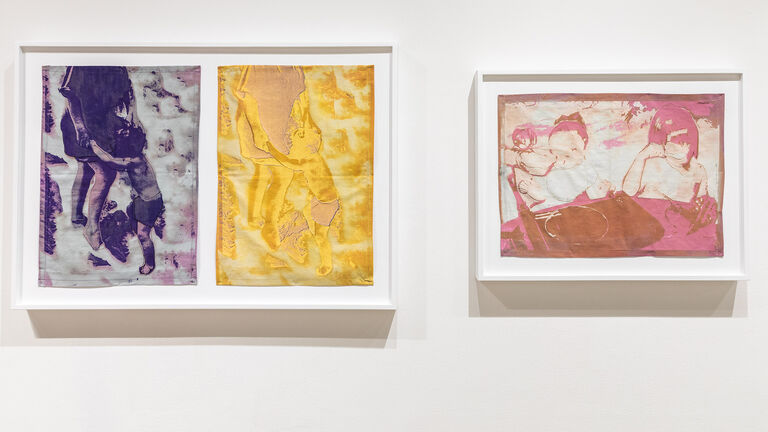
Undergraduate Overview
Undergraduate Overview
Undergraduate students who concentrate their studies within Printmedia engage a dynamic learning environment where traditional and contemporary practices are informed by the ever-expanding definition of image making.
Printmedia at SAIC may take the form of conventional approaches such as, intaglio, lithography, silkscreen, book arts and relief, as well as digital printing and fabrication. Alternative and experimental means of production are also explored. Students generate work to be shared, exhibited, performed or situated in site-specific contexts.
Course topics include:
- Printmedia Practices
- Artists’ Books, Offset Productions
- Reproduction and Representation
- Adventures in Self-Publishing
- Image Retainer: Print in the Expanded Field
- Advanced Undergraduate Studio
Undergraduate Admissions Requirements & Curriculum Overview
-
To apply to the School of the Art Institute of Chicago (SAIC), you will need to fill out an application and submit your transcripts, artist's statement, and letters of recommendation. And most importantly, we require a portfolio of your best and most recent work—work that will give us a sense of you, your interests, and your willingness to explore, experiment, and think beyond technical art, design, and writing skills.
In order to apply, please submit the following items:
Bachelor of Fine Arts in Studio Portfolio
Submit 10–15 pieces of your best and most recent work. We will review your portfolio and application materials for merit scholarship once you have been admitted to SAIC.
When compiling a portfolio, you may concentrate your work in a single discipline or show work in a breadth of media. The portfolio may include drawings, prints, photographs, paintings, film, video, audio recordings, sculpture, ceramics, fashion designs, graphic design, furniture, objects, architectural designs, websites, video games, sketchbooks, scripts, storyboards, screenplays, zines, or any combination of the above.
Learn more about applying to SAIC's Bachelor of Fine Arts in Studio, or view our portfolio preparation guide for more information.
-
Studio
69
- CP 1010 Core Studio Practice I (3)
- CP 1011 Core Studio Practice II (3)
- CP 1020 Research Studio I (3)
- CP 1022 Research Studio II (3)
- SOPHSEM 2900 (3)
- PROFPRAC 3900 (3)
- CAPSTONE 4900 (3)
- Studio Electives (48)
PROFPRAC and CAPSTONE are now required for new incoming students beginning in the 2015-16 academic year.
Art History
15
- ARTHI 1001 World Cultures/Civilizations: Pre-History—19th Century Art and Architecture (3)
- Art History Elective at 1000 level (3)
- Art History Electives (9)
Liberal Arts
30
- ENGLISH 1001 First Year Seminar I (3)
- ENGLISH 1005 First Year Seminar II (3)
- Natural Science (6)
- Social Science (6)
- Humanities (6)
- Liberal Arts Electives (6)
General Electives
6
- Studio, Art History, Liberal Arts, AAP, or EIS
Total Credit Hours
120
* BFA students must complete at least 6 credit hours in a class designated as "off campus study." These credits can also fulfill any of the requirements listed above and be from any of the divisions (Art History, Studio, Liberal Arts, or General Electives).
BFA With Distinction—SAIC Scholars Program: The SAIC Scholars program is a learning community of BFA students pursuing rigorous study in both their academic coursework and their studio pathways. There are two opportunities for interested students to apply to the SAIC Scholars Program: at the time of admission to the school, and after they have completed 30 credits of study at SAIC. Students pursuing the latter option are required to formally submit an application to the Undergraduate Division. Once admitted to the SAIC Scholars Program, students are required to successfully complete a minimum of six designated scholars courses. Students who complete the program will graduate with distinction.
BFA in Studio with Thesis Option (Liberal Arts or Visual Critical Studies): BFA students may complete a nine-credit, research-based academic thesis as part of their studies within the 126 credits for the BFA in Studio degree. BFA with Thesis course sequences are offered over 3 semesters through the departments of Liberal Arts or Visual and Critical Studies (VCS). Students who are interested in one of the thesis options should follow the steps outlined below in the beginning of the junior year.
Requirements for the BFA: Studio Art with Liberal Arts Thesis
Step One: Students are required to meet with the Chair of the Liberal Arts department in the beginning of their junior year.
Step Two: With the Department Chair's approval, the student enrolls in the following courses beginning in the spring term of their junior year:
- SOCSCI or HUMANITY 3900 Academic Research and Writing (3 credits)
- LIBARTS 4800 Undergraduate Thesis: Research/Writing I (3 credits)
- CAPSTONE 4900 Liberal Arts Undergraduate Thesis: Research/Writing II (3 credits)
Step Three: The completed thesis must be approved by both the Thesis II instructor and the Chair of Liberal Arts. Students must make a formal presentation and participate in the Undergraduate Thesis Symposium in their senior year.
Requirements for the BFA: Studio Art with Visual and Critical Studies (VCS) Thesis
Step One: Students are required to meet with the Visual and Critical Studies Undergraduate Coordinator in or by the beginning of their junior year.
Step Two: With the VCS Coordinator's approval, the student enrolls in the first of the three-course sequence beginning in the spring term of their junior year:
- VCS 3010 Tutorial in Visual & Critical Studies (3 credits)
- VCS 4800 Undergraduate Thesis Seminar: Research & Writing I (3 credits)
- CAPSTONE 4900 VCS Undergraduate Thesis Seminar: Research & Writing II (3 credits)
Step Three: Completion of thesis must be approved by both the Thesis II instructor and the VCS Undergraduate Coordinator. Students must make a formal presentation and participate in the Undergraduate VCS Thesis Symposium in the senior year.
Total credits required for minimum residency 60 Minimum Studio credit 42
Course Listing

Freshman and Transfer Deadline: June 1
Elise Seigenthaler, "Hippocampus, Gateau d’annversaire, and Mom’s Shoes," 2019, photography, screen print, thread, bed sheets / fabric